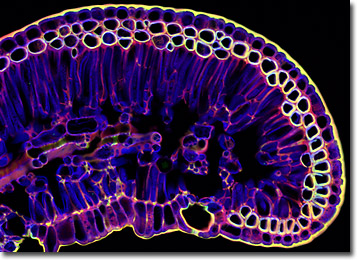 |
 |
 |
|
||||||||||||||||||||||||
 | ||||||||||||||||||||||||
 | ||||||||||||||||||||||||
 | ||||||||||||||||||||||||
Confocal Microscopy Image Gallery
Plant Tissue Autofluorescence Gallery
Cycad Leaf
Cycads are ancient, woody plants with large, pinnately compound leaves that cause them to often be confused with palms or ferns, though they are not closely related to either. The cycads comprise the order of Cycadales and, along with ginkgoes and conifers, comprise one of the world’s major groups of gymnosperms, plants that bear naked seeds.

The cycads have inhabited the Earth for well over 200 million years, first appearing during the Permian Era. Their distribution and numbers were much greater than they are today, especially during the Jurassic Period, which is sometimes referred to as the “Age of Cycads.” Only 11 extant genera of cycads are recognized containing only a few hundred species, many of which are rare or endangered. The slow growth and population turnover characteristic of many living cycad species has contributed to their decline, as has habitat destruction and over collection.
Some of the most familiar cycads in North America are those that belong to the genus Zamia, which are sometimes known by various common names including coontie and Florida arrowroot. These plants formerly provided an important component to the diet of the Seminole Indian tribes that inhabited Florida. The native peoples would dig up their starchy underground stems and cut them up into pieces that could be pounded into a powder. This powder was then washed repeatedly in order to separate the starch from other substances, and the pasty like material was fermented and dried, resulting in a second type of powder. The final product, sometimes called arrowroot, could be used in baking similar to flour.
Contributing Authors
Nathan S. Claxton, Shannon H. Neaves, and Michael W. Davidson - National High Magnetic Field Laboratory, 1800 East Paul Dirac Dr., The Florida State University, Tallahassee, Florida, 32310.
